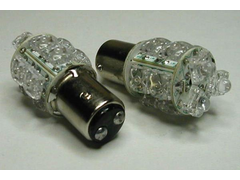I've got a pair of SVC LED rear indicators; very smart. I've also got resistors to fit.
Where abouts in the circuit do they go? and are they in series or parallel?
I'm only a simple sailor so help would be appreciated.
Thanks,
Geoff.


It's daft questions day today!
I've got a pair of SVC LED rear indicators; very smart. I've also got resistors to fit.
Where abouts in the circuit do they go? and are they in series or parallel?
I'm only a simple sailor so help would be appreciated.
Thanks,
Geoff.
Hi.
One lead to earth.
the other to the indicator feed.
Resistors need to go in series with each indicator light. They need to dissipate approx. 20 watts for indicators, so can get hot, bear this in mind
when locating them.
If I remember right, I got some fancy alloy heatshielded resistors from SVC, which didn't work, in the end I just substituted some simple 5 or so
Ohm, 20+ watt, ceramic resistors from Maplin for a few pence each. Indicators now work a treat.
[Edited on 18/4/06 by JohnN]
quote:
Originally posted by JohnN
Resistors need to go in series with each light. They need to dissipate approx. 20 watts for a brake light, so can get hot, bear this in mind when locating them.


as piddy stated
one end to earth other end to indicator supply
obviously one for each side
Well spotted, RazMan, I was of course talking complete boŁ$%cks........ I'll get my coat.
Sorry to contradict your statement razman, but if you put a resister in parrallel, then there will still be 12v supplied to the leds, so the current
flowing through will still be the same? The only device to alter current in parrallel, is an ultra low resistance such as a direct link of copper
(normally called a shunt but only used on ammeters).
When you put a resister in series, you reduce the voltage across the led and therefore the current flowing through them.
quote:
Originally posted by nitram38
Sorry to contradict your statement razman, but if you put a resister in parrallel, then there will still be 12v supplied to the leds, so the current flowing through will still be the same? The only device to alter current in parrallel, is an ultra low resistance such as a direct link of copper (normally called a shunt but only used on ammeters).
When you put a resister in series, you reduce the voltage across the led and therefore the current flowing through them.
That makes more sense.
If the led has a low resistance then the flasher will go faster ('hotwire' flasher, not electronic type).
Putting the resister in parallel will mimic a greater load and therefore allow the flasher to run at the correct speed.